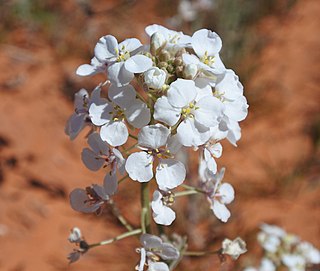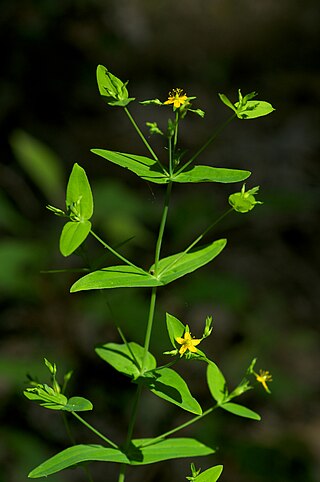
Anthocharis cethura, the desert orangetip or Felder's orangetip, is a species of butterfly in the subfamily Pierinae. It is native to the southwestern United States and northern Mexico, where it lives on hills and ridges in rocky desert habitat.

Echinacea angustifolia, the narrow-leaved purple coneflower or blacksamson echinacea, is a species of flowering plant in the family Asteraceae. It is native to North America, where it is widespread across much of the Great Plains of central Canada and the central United States, with additional populations in surrounding regions.
Euchloe guaymasensis, the Sonoran marble or Sonoran white, is a species of butterfly in the family Pieridae. It is native to Sonora in Mexico and has been seen once in Arizona in the United States.

Berberis pinnata is a species of shrub in the barberry family. Common names include California barberry, wavyleaf barberry, and shinyleaf mahonia. It is similar to the Oregon-grape, and is sometimes called the California Oregon-grape.

Streptanthus glandulosus subsp. niger is an endangered subspecies of flowering plant within the family Brassicaceae. Like other genus members, this herb has wavy petal margins with perimeter calluses that discourage larval herbivory. This plant is endemic to the Tiburon Peninsula of Northern California, and occurs at elevations below 150 m on serpentine grasslands. The common name for this subspecies is Tiburon jewelflower or black jewelflower. This annual herb blooms in May and June and displays dark purple sepals. The etymology of this genus scientific name derives from the Greek word streptanthus, meaning twisted flower, with reference to the notable wavy margins of the petals. The subspecies name niger relates to the color of the seeds being black, although an alternate account cites the dark color of the petals as the source of the appellation.

Descurainia is a genus of plants in the family Brassicaceae which are known commonly as the tansymustards. The genus name commemorates French botanist and herbalist François Descurain (1658–1749). The plants are similar in appearance to other mustards, sending up long erect stems and bearing small yellow or whitish flowers. Many species are noxious weeds. Some species are toxic to livestock and become a nuisance when they grow in grazing fields. Plants of this genus are found worldwide in temperate regions. Descurainia sophia,, is the type species of Descurainia.

Turritis glabra, commonly known as tower rockcress or tower mustard, is a tall, slim, grey-green plant with small creamy flowers at the top of the stem. It usually grows on poor chalky or sandy soils, in open situations. It is native to Europe, Asia, and North Africa, and it is widespread in North America where it is also probably native. It can be found in many other parts of the world as an introduced species.

Chorispora tenella is a species of flowering plant in the mustard family known by several common names, including purple mustard, blue mustard, musk mustard, and crossflower. This mustard is native to parts of Eurasia but is well known in other parts of the world, particularly in temperate regions, as an introduced species and a noxious weed.
Descurainia californica is a species of flowering plant in the family Brassicaceae known by the common name Sierra tansymustard. This plant is native to western North America from California to Wyoming. It is a resident of varied habitats from mountain forest to sage scrub. This spindly mustardlike plant has a single thin stem which branches and may reach over half a meter in height. Its sparse leaves are divided into two to four pairs of dull green lobes each one to six centimeters long. The tiny bunched flowers at the tip of each stem are bright yellow. The fruit is a tiny podlike silique on a straight pedicel. Pedicels holding fruits stick out from the stem at intervals.

Boechera stricta is a species of flowering plant in the mustard family known by the common name Drummond's rockcress. It is native to much of North America, including most of Canada, and the western and northeastern United States.

Dimorphocarpa wislizeni, commonly known as spectacle pod, Wislizeni's spectaclepod, and touristplant, is a flowering plant in the mustard family native to western North America, where it occurs in the southwestern United States as far east as Oklahoma and Texas, and Baja California, Sonora, Chihuahua, and Coahuila in Mexico.

Descurainia incana is a species of flowering plant in the mustard family known by the common name mountain tansymustard. It is native to much of North America, including most of Canada, the western United States, and Baja California. It is known from many types of habitat. It is a biennial herb with a slender, greenish, often hairy stem sometimes exceeding a meter tall. The leaves are narrowly to widely oval in shape, the lower ones lobed and sometimes compound, the upper generally unlobed. The mustardlike inflorescence is a series of developing fruits beneath an elongating cluster of small bright yellow flowers. The fruit is a thin, pointed silique up to 2 centimeters long.

Hypericum mutilum is a species of St. John's wort known by the common name dwarf St. John's wort. It is native to parts of North America and is present in other parts as an introduced species. It is an annual or perennial herb taking a multibranched erect form up to about 60 centimeters tall. The oval green leaves are one or two centimeters long and are covered in tiny glands. The inflorescence is a compound cyme of tiny flowers. H. mutilum subsp. mutilum and subsp. boreale have a diploid number of 16, and H. mutilum subsp. boreale can have a diploid number of 18.

Stanleya pinnata is a species of flowering plant in the family Brassicaceae known as desert prince's-plume. It is a perennial herb or shrub native to North America.

Streptanthus glandulosus is a species of flowering plant in the mustard family known by the common name bristly jewelflower. It is native to California and southwestern Oregon, where it grows in many types of habitat, including grassland, chaparral, and woodlands. Genetic and other analyses indicate that it is a species complex with ten subspecies which evolved as populations were isolated from each other. The complex includes subspecies previously considered separate species, such as the rare Tiburon jewelflower endemic to the San Francisco Bay Area. Plants in the complex are variable. In general they are annual herbs growing 10 centimeters to over a meter in height. They may be hairless hairy to bristly. The ephemeral basal leaves have blades borne on winged petioles. Leaves higher on the stem are linear to lance-shaped and clasp the stem at their bases. Flowers occur at intervals along the upper stem. Each flower has an urn-shaped calyx of sepals one-half to over one centimeter long which can be almost any color from white to yellowish to pink or purple to nearly black. Purple, white, or purple-veined white petals emerge from the tip. The fruit is a straight or curving silique up to 11 centimeters long.
Streptanthus insignis is an uncommon species of flowering plant in the mustard family known by the common names plumed jewelflower and San Benito jewelflower. It is endemic to California, where it is known only from the Inner Central Coast Ranges. It grows in grassland and chaparral habitat, usually on serpentine soils. It is an annual herb producing a hairy, bristly, branching stem up to about 60 centimeters long. The lance-shaped basal leaves are borne on short petioles. Leaves midway up the stem are longer, and those near the top are shorter. They sometimes clasp the stem at their bases. Flowers occur at intervals along the upper stem. The uppermost flowers are often sterile and different in form. Each fertile flower has a bell-shaped calyx of sepals which is purple or greenish-yellow depending on subspecies. The petals at the tip are purplish or yellowish, also depending on subspecies. The fruit is a flat, straight silique which may be over 11 centimeters long.

Thelypodium integrifolium is a species of flowering plant in the mustard family known by the common names entireleaved thelypody and foxtail thelypodium. It is native to much of the western United States, including the Great Basin and surrounding plateaus and deserts.
Descurainia torulosa is a species of flowering plant in the family Brassicaceae known by the common names Wyoming tansymustard and Wind River tansymustard. It is endemic to Wyoming in the United States, where it is found in the Absaroka Range and some buttes in the Great Divide Basin.

Streptanthus bracteatus is a species of flowering plant in the mustard family known by the common names bracted jewelflower and bracted twistflower. It is endemic to Texas in the United States.

Noccaea fendleri more commonly known as wild candytuft and alpine pennycress is a wildflower in the mustard family from western North America. It grows in mountains from northern Mexico to the northern United States. It blooms early in the spring and provides nectar to butterflies.

















